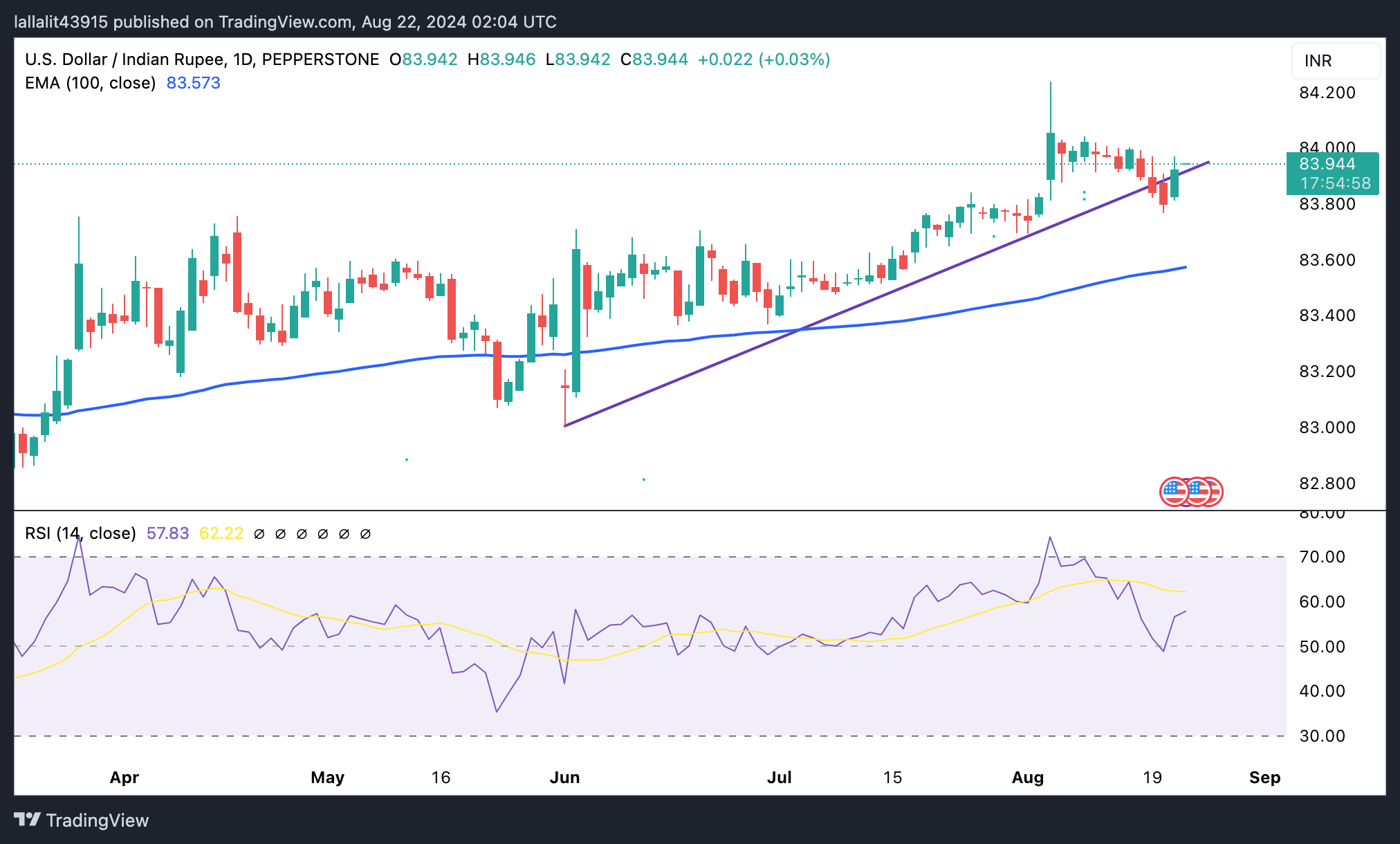USD/INR rebounds ahead of Indian PMI data, RBI’s MPC Minutes

- The Indian Rupee weakens, snapping the three-day winning streak in Wednesday’s early Asian session.
- Strong USD demand from importers and outflows from equities have weighed on the INR.
- Investors will monitor the advanced Indian August HSBC PMI data and the RBI’s MPC Minutes, which are due on Thursday.
The Indian Rupee (INR) loses ground on Thursday, pressured by concerns about importers’ US Dollar (USD) demand and foreign equity outflows. Nonetheless, the further decline of crude oil prices might underpin the INR as India is the world’s third-largest oil consumer and importer. The downside of the INR might also be limited amid the likely intervention from the Reserve Bank of India (RBI), which might sell USD to stabilize the Indian Rupee.
Traders will keep an eye on the first reading of the Indian August HSBC Purchasing Managers Index (PMI) reports on Thursday, along with the RBI Monetary Policy Committee (MPC) Minutes. On the US docket, the preliminary US S&P Global Purchasing Managers Index (PMI) for August is due later in the day. Meanwhile, rising expectations of a Federal Reserve interest rate cut in September could drag the Greenback lower.
Daily Digest Market Movers: Indian Rupee remains vulnerable amid multiple challenges
- The Indian Rupee is down 0.2% against the US Dollar in August, making it the worst-performing Asian currency.
- The INR “faces persistent challenges — a widening trade deficit, ongoing foreign outflows, and relentless demand for USD from importers,” said Amit Pabari, managing director at FX advisory firm CR Forex in Mumbai.
- According to the minutes of the Federal Reserve’s (Fed) July meeting released Wednesday, “the vast majority” of participants observed that it would likely be appropriate to cut the interest rate in the September meeting if the data continued to come in about as expected.
- Markets are fully pricing in a September cut, with a full percentage point worth of rate cuts anticipated by the end of this year.
- The preliminary estimate of the benchmark revision indicated an adjustment to March 2024 total Nonfarm employment of -818,000 (-0.5%), the US Bureau of Labor Statistics showed on Wednesday.
Technical Analysis: USD/INR maintains its constructive bias
Indian Rupee edges lower on the day. The USD/INR keeps the bullish environment on the daily timeframe as the price is well-supported above the key 100-day Exponential Moving Average (EMA). The pair bounces back above the 11-week-old uptrend line, while the 14-day Relative Strength Index (RSI) points higher above the midline again, indicating there could still be room for further upward movement before the market potentially encounters resistance.
The crucial upside barrier for USD/INR emerges near the 84.00 psychological mark. Any follow-through buying could pave the way to the record high of 84.24 en route to 84.50.
On the downside, the low of August 20 at 83.77 acts as an initial support level for the pair. Extended losses will see a drop to the 100-day EMA at 83.56, followed by 83.36, the low of June 28.
Indian Rupee FAQs
The Indian Rupee (INR) is one of the most sensitive currencies to external factors. The price of Crude Oil (the country is highly dependent on imported Oil), the value of the US Dollar – most trade is conducted in USD – and the level of foreign investment, are all influential. Direct intervention by the Reserve Bank of India (RBI) in FX markets to keep the exchange rate stable, as well as the level of interest rates set by the RBI, are further major influencing factors on the Rupee.
The Reserve Bank of India (RBI) actively intervenes in forex markets to maintain a stable exchange rate, to help facilitate trade. In addition, the RBI tries to maintain the inflation rate at its 4% target by adjusting interest rates. Higher interest rates usually strengthen the Rupee. This is due to the role of the ‘carry trade’ in which investors borrow in countries with lower interest rates so as to place their money in countries’ offering relatively higher interest rates and profit from the difference.
Macroeconomic factors that influence the value of the Rupee include inflation, interest rates, the economic growth rate (GDP), the balance of trade, and inflows from foreign investment. A higher growth rate can lead to more overseas investment, pushing up demand for the Rupee. A less negative balance of trade will eventually lead to a stronger Rupee. Higher interest rates, especially real rates (interest rates less inflation) are also positive for the Rupee. A risk-on environment can lead to greater inflows of Foreign Direct and Indirect Investment (FDI and FII), which also benefit the Rupee.
Higher inflation, particularly, if it is comparatively higher than India’s peers, is generally negative for the currency as it reflects devaluation through oversupply. Inflation also increases the cost of exports, leading to more Rupees being sold to purchase foreign imports, which is Rupee-negative. At the same time, higher inflation usually leads to the Reserve Bank of India (RBI) raising interest rates and this can be positive for the Rupee, due to increased demand from international investors. The opposite effect is true of lower inflation.
